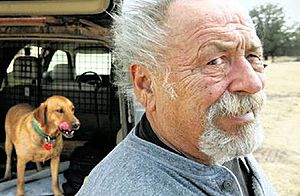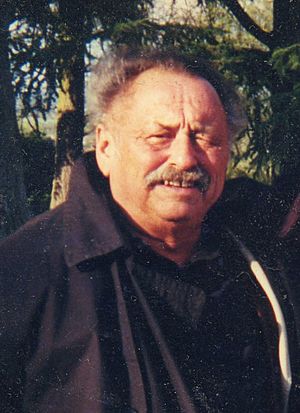Jim Harrison facts for kids
Quick facts for kids
Jim Harrison
|
|
|---|---|
 |
|
| Born | James Harrison December 11, 1937 Grayling, Michigan, U.S. |
| Died | March 26, 2016 (aged 78) Patagonia, Arizona, U.S. |
| Occupation | |
| Alma mater | Michigan State University (BA 1960, MA 1964) |
| Genre | Fiction, non-fiction, poetry |
| Spouse | Linda King Harrison (d. October 2, 2015) |
| Children | 2 daughters: Jamie Potenberg and Anna Hjortsberg |
James Harrison (born December 11, 1937 – died March 26, 2016) was an American writer. He wrote many different kinds of books, including poetry, novels, and essays. He published over 30 books! He also wrote screenplays for movies and articles about food, travel, and sports. Jim Harrison said that his poetry was the most important type of writing to him.
Harrison wrote 24 novellas, which are like short novels. He was known as a master of this writing style. His first big success came in 1979 with a group of three novellas called Legends of the Fall. Two of these stories were later made into movies.
His books have been translated into many languages, such as Spanish, French, and Chinese. He won several awards, including a Guggenheim Fellowship in 1969. He also received the Mark Twain Award in 1990 for his important contributions to literature. In 2007, he was welcomed into the American Academy of Arts & Letters. Harrison once wrote that his dream of writing a great poem or novel "devoured" his life.
Contents
About Jim Harrison's Life
Jim Harrison was born in Grayling, Michigan. His parents, Winfield and Norma, loved to read. Jim was close to his older brother, John. He also had three younger siblings: Judith, Mary, and David. When he was a child, an accident caused him to lose sight in one eye.
He finished high school in Haslett, Michigan, in 1956. In 1962, when he was 24, his father and sister Judy died in a car accident.
In 1959, Jim married Linda King, and they had two daughters. He studied at Michigan State University, earning two degrees in comparative literature. After teaching English for a short time, Harrison became a full-time writer in 1966.
His writings appeared in popular magazines like The New Yorker, Esquire, and Rolling Stone. Two of his novellas were made into films: Revenge (1990) and Legends of the Fall (1994).
Many of Harrison's stories take place in wild, open areas of North America. These include places like Michigan's Upper Peninsula, Montana's mountains, and the Arizona–Mexico border.
Harrison lived in Patagonia, Arizona, Livingston, Montana, and Grand Marais, Michigan. He appeared on Anthony Bourdain's TV shows No Reservations and Anthony Bourdain: Parts Unknown.
Jim Harrison passed away from a heart attack on March 26, 2016, in Patagonia, Arizona.
Jim Harrison's Books and Stories
Starting His Writing Career
Harrison once said he became a novelist after falling off a cliff while bird hunting. While he was recovering, his friend Thomas McGuane suggested he write a novel. This led to his first novel, Wolf: A False Memoir, published in 1971. It's about a man looking for a wolf in the Michigan wilderness.
Next, he wrote A Good Day to Die (1973), which talked about environmental issues. Then came Farmer (1976), a story about a country school teacher dealing with getting older and his mother's illness.
His first collection of novellas was published in 1979, titled Legends of the Fall. The famous actor Jack Nicholson, a friend of Harrison's, helped him out. When Nicholson heard Harrison needed money, he sent him $30,000. This money allowed Harrison to write Legends of the Fall. The main story in the book is an epic tale covering 50 years. It's about a father and his three sons in the Rocky Mountains around the time of World War I.
The novella became a very important type of writing for Harrison. He published seven more novella collections during his life. The last one, The Ancient Minstrel, came out just before he died in 2016.
After writing Warlock (1981) and Sundog (1984), Harrison published Dalva (1988). This is one of his most famous novels. It's a complex story set in rural Nebraska. It follows a woman searching for the son she gave up for adoption and his father. The story also includes memories of her great-grandfather, a naturalist who lived during the Civil War. Many of these characters also appear in The Road Home (1998), a complex book told by five different people.
By the time Harrison turned 60 in 1998, he had published many novels and poetry books.
Later Writings
In his last 18 years, after turning 60, Harrison continued to be very productive. He published more novels, poetry books, and a memoir called Off to the Side. He also released The Raw and the Cooked, a collection of his essays about food.
During these later years (1999-2016), Harrison focused more on longer novels. He wrote two ambitious novels set in Michigan’s Upper Peninsula: True North (2004) and its sequel Returning to Earth (2007).
Harrison’s The English Major (2008) is a road trip novel. It's about a 60-year-old former teacher and farmer from Michigan. After a divorce, he travels west to clear his mind. On his journey, he meets his son, talks about life with an old doctor friend, and tries to rename all the states and their state birds.
Harrison also wrote two funny detective novels: The Great Leader: A Faux Mystery (2012) and The Big Seven (2015). Both feature a detective named Sunderson. Critics praised The Great Leader, with one calling Harrison's writing "very close to magic."
Jim Harrison's Poetry
Poetry Publications
Jim Harrison was inspired by the poet Pablo Neruda. He wrote his first good poems in the early 1960s. In 1965, he had poems published in magazines like The Nation and Poetry. With help from poet Denise Levertov, he published his first poetry book, Plain Song (1965).
Throughout his life, Harrison's poetry appeared in many publications. He published 17 collections of poetry. The Shape of the Journey: New and Collected Poems (1998) includes over 120 of his poems. After he died, a book called Jim Harrison: The Essential Poems (2019) was published, chosen from nearly 1000 poems he had written.
Harrison knew that his poetry might not be popular with everyone. He hoped that by working with a small publisher like Copper Canyon Press, his poetry books would stay in print.
His final book of poetry, Dead Man's Float, was published in 2016, the same year he died.
Poetry Influences
Harrison started studying poetry as a teenager. When he was young, he thought of himself as "a poet and nothing else." Some of his early influences included Arthur Rimbaud, Richard Wright, and Walt Whitman.
He also studied many other poets, including W.B. Yeats and Dylan Thomas. Harrison was also inspired by poets from other countries, like the French poet Rene Char and the Russian poet Sergei Yesenin. He felt a special connection to them because they both came "from humble beginnings out in the country." Harrison's poems called Letters to Yesenin (1973) were inspired by Yesenin.
Harrison's practice of Zen Buddhism was important to his poetry. He felt it helped keep his "head from flying off." He learned about Zen-inspired poetry from other poets like Gary Snyder. He wrote that his long poem The Theory and Practice of Rivers (1986) was "basically Zennist." His collection of 57 poems After Ikkyū (1996) was named after the Zen monk Ikkyū.
Nature in His Poetry
Harrison's poetry often focuses on the natural world. Animals, especially birds and dogs, appear often in his poems. Wild, untouched places are common settings. His poetry helps us understand our connection to other life on Earth. Harrison wrote that his "intimacy with the natural world has been a substitute for religion." Here is a small part of his poem "The River":
...Then again maybe we'll be cast
at the speed of light through the universe
to God's throne. His hair is bounteous.
All the 5,000 birds on earth were created there.
The firstborn cranes, herons, hawks, at the back
so as not to frighten the little ones.
Even now they remember this divine habitat.
Shall we gather at the river, this beautiful river?
We'll sing with the warblers perched on his eyelashes.—Jim Harrison, Dead Man's Float (2016)
Jim Harrison and Movies
Jim Harrison also worked on films. His involvement began when he sold the movie rights for his book Legends of the Fall. He helped write the screenplay for the film, also called Legends of the Fall. This movie was directed by Edward Zwick and starred Brad Pitt and Anthony Hopkins. It won an Academy Award in 1995 for its cinematography (how it was filmed). Jim Harrison received a writing credit for the movie.
He also wrote or co-wrote other film scripts. These include Cold Feet (1989) and Revenge (1990), which starred Kevin Costner. For his work on the screenplay for Wolf (1994), starring Jack Nicholson, Harrison won an award called the Saturn Award for Best Writing.
Filmography
Writer
- Dalva (1996)
- Carried Away (1996)
- Legends of the Fall (1994)
- Wolf (1994)
- Revenge (1990)
- Cold Feet (1989)
Producer
- Wolf (1994)
Appearing as Himself
- Here is Something Beautiful (announced)
- La grande librairie (2009-2015)
- Café littéraire (2010)
- The Practice of the Wild (2010)
- Amérique, notre histoire (2006)
- Le cercle de minuit (1995)
Images for kids
See also
 In Spanish: Jim Harrison para niños
In Spanish: Jim Harrison para niños




